This article derives from a presentation from Product Marketing Trailblazers in December 2021. Watch this presentation, and others, via our OnDemand service.
Thank you for reading this article on developer marketing. I hope it helps you build phenomenal developer campaigns and achieve success.
I'm Abhishek Ratna. I'm a mechanical engineer by education, was a professional developer in my early career, and have been a marketer for over a decade. I've marketed everything from video games to fashion to shoes, to enterprise software to advertising solutions to APIs.
During this time, I've worked with and learned from incredible marketers at Facebook, Microsoft, Zulily, and Databricks. Right now, I'm at Google, where I focus on growth and product marketing efforts for TensorFlow. My audience is our AI and machine learning developers.
In this article, we'll talk about:
- Why developer marketing matters,
- Why developers hate (traditional) marketing,
- Why you need to establish developer marketing personas and segments,
- How to craft your developer personas,
- How to build content for your developers,
- Where to uncover compelling topics for developers,
- Why running developer campaigns is hard,
- Persona maker: A tool for segmentation, and
- KPIs for marketing and content performance.
Why developer marketing matters
The business of marketing to developers has evolved rapidly over the last few years.
As recently as a decade ago, buying technology was a tightly controlled process. Central IT teams dictated which tools and technologies could be used in their organizations. They oversaw budgets and procurement and had strict policies governing the use of the software.
Times have changed. Mobile technologies appeared, BYOD came along, and the cloud was born. Software development transformed dramatically. Waterfall models gave way to agile models that cleared the way for DevOps.
Businesses started competing on their ability to build and ship continuously. The API economy broke the stranglehold of monolithic service providers and companies started building their own stacks of tools based on open standards.
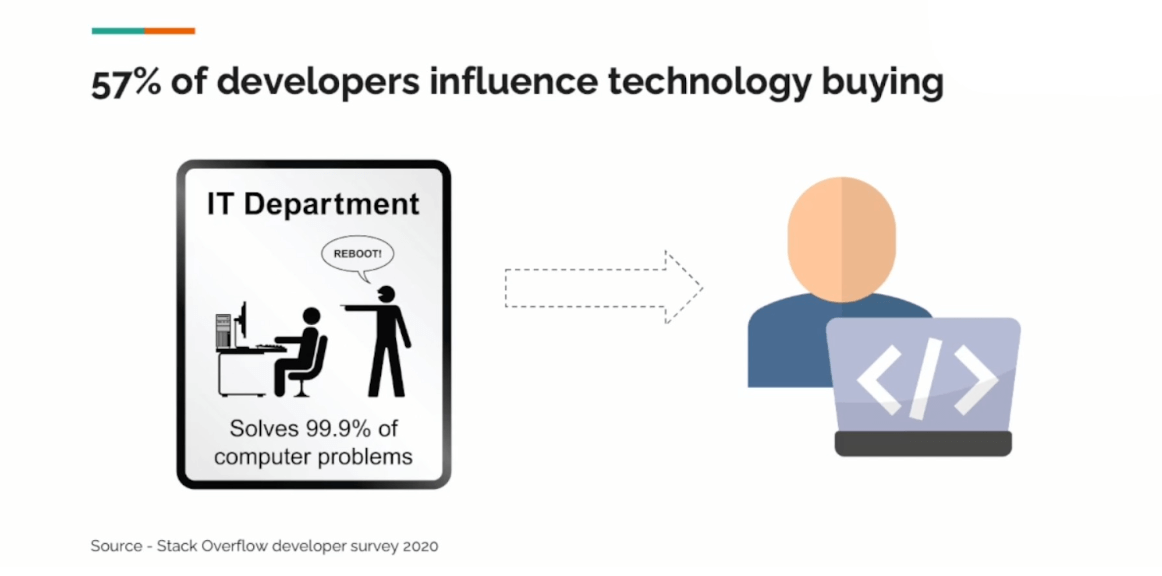
As of today, developers are deeply embedded in the technology buying process. 57% of developers, across organizations of all sizes, influence technology buying. The more developers are convinced about the value of your product, the more likely you are to scale your community, win deals, and grow your pipeline.
Why developers hate (traditional) marketing
Developer marketing is inherently very difficult, and there are plenty of memes to back that up. In my first true developer marketing role at Microsoft, the first thing I learned on the job was that developers hate marketing.
What I believe that means is that they dislike traditional broad marketing. They cannot stand clickbait, paywalls, gated content, or tall claims. Developers are busy solving problems and building products.
They have strong opinions about what they need and they trust their own experience. Marketing messages are largely discarded, sometimes analyzed in excruciating detail, and shortcomings are mercilessly exposed and trolled.
So, how do developers buy or evaluate technologies? StackOverflow found that developers dive straight into product trials. They trust their peers' advice. They read reviews and debate on forums and communities. The one traditional marketing channel they seem to trust is the product website.
Why you need to establish developer marketing personas and segments
So why are developer personas and segments important? As we saw, developers aggressively weed out the noise and zoom in on relevant content. To win mindshare, you need to understand and establish your developer personas.
The word developer can encompass many different people with different skills, motivations, and attitudes. For example, a data scientist cares less about the code and more about the learnings that his or her model brings to the business. Data scientists focus on running successful experiments to build great models with high accuracy.
This is very different from a data engineer who solves complex problems in sourcing, transforming, and piping data. Data engineers are tasked with ensuring high-quality, fresh, and relevant data for their businesses.
They care a lot more about technical detail, uptime, data quality, and operational metrics. In contrast, web developers focus on bringing the user experience to life, while making sure their apps and sites are highly performant.
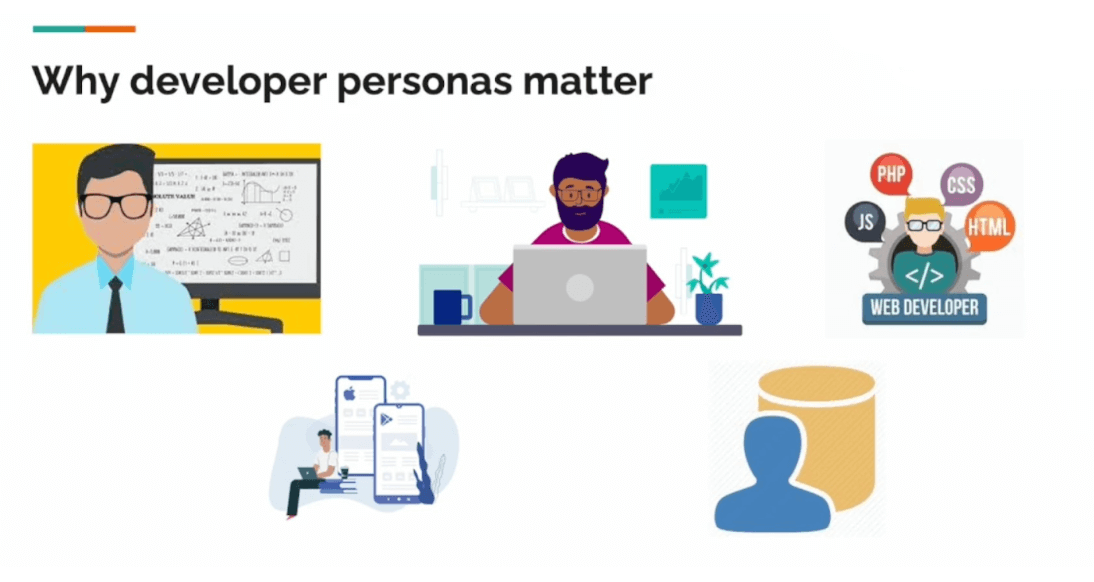
This is just a small sample of the differences in personalities that you will encounter when working with developers. As you can see, each developer subgroup differs greatly from the others.
The complexity increases once you take into account other variables, like their experience levels. Are they new? Have they been working on this track for a while? What technologies do they use? And so on. A one-size-fits-all approach does not work for your developer marketing content.
To get started with developer personas, I highly recommend reading through Cliff Simpkins’ chapter on developer persona building in the excellent Developer Marketing and Relations: The Essential Guide.
How to craft your developer personas
My approach to developer persona building involves four phases.
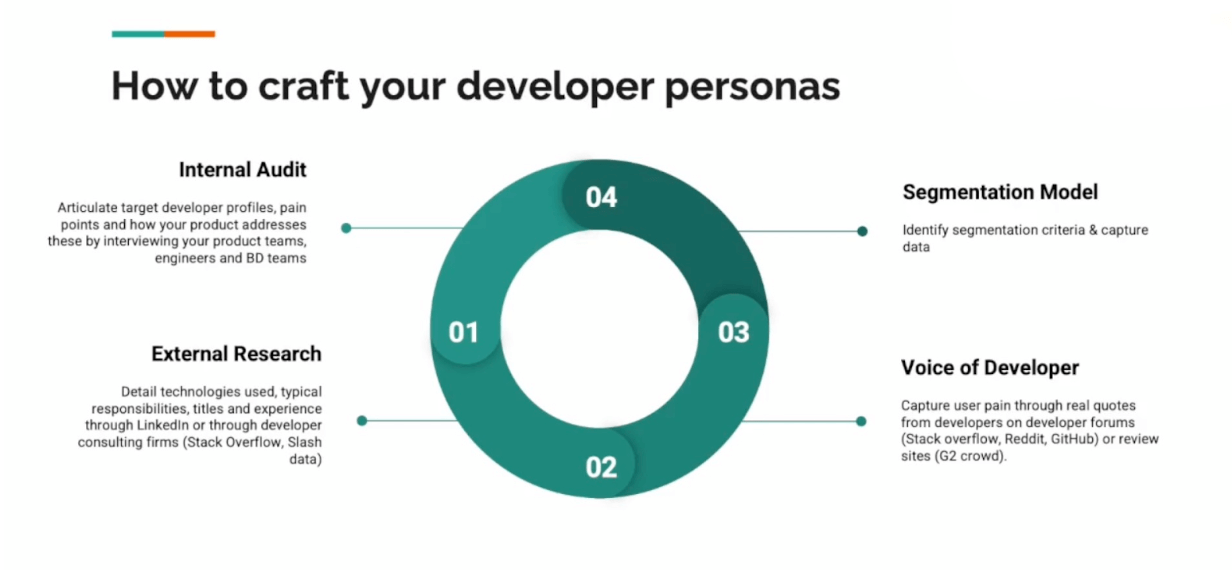
Phase 1: The internal audit
It all starts with an internal audit with your product teams, engineers, developer relations folks, and biz dev teams. These stakeholders deeply understand your end-user developers and the most important problems they’re facing, as well as the attitudes and nuances of the audiences you're trying to convince.
Phase 2: External research
After the audit is done and a straw man has been created, it's time to look at external research. This is where you will flesh out firmographic details and understand things like what tools your devs typically use and what their typical experience levels are.
You can be hacky and curate data from LinkedIn to build something quick and dirty, or you can go to the other extreme of sophistication and work with a specialized developer consulting firm like Stack Overflow or SlashData.
Phase 3: Voice of developer
Once you're done with the external audit, it's time to capture the voice of your developers. Look for feedback and comments from your target devs that articulate their pain points. Your product and engineering partners highly value verbatim quotes and experiences, so this will allow your work to gain more internal buy-in.
Phase 4: Segmentation model
Finally, it's time to establish a clear segmentation strategy for your personas. Most marketers practice segmentation of some kind. That being said, these approaches run into a few problems. Here are just two examples among many, many more:
Technologies evolve fast. APIs that were cutting edge just a couple of years ago can become obsolete, and the problems that developers are solving change very quickly over time.
- Developers code as a hobby on the side and learn continuously. Their personal motivations and technology choices can differ significantly from their industry tooling or their day-to-day jobs, so trying to target them with industry-specific messaging may not bear the kind of fruit that you’re hoping for.
- There isn't one perfect approach to rule them all, but I believe that your segmentation criteria should be agile, and should be revisited regularly. Personally, I've found a combination of decision-making authority, professional titles and profiles, technologies they're working on, and goals or common use cases to be good ways of segmenting my audiences.
How to build content for your developers
Let's zoom out a little bit and think about how to build compelling content for your developers, starting with some developer psychology.
Common developer traits
I mentioned that each developer is different; however, there are some commonalities and traits that you can consistently find across different developer populations.
For one, developers are doers. They learn by doing. They're constant learners who keep evolving their skills or branching into new coding disciplines. They're creative problem solvers, who wish to stay up to date with the latest technologies and approaches.
They are heavily community driven. In fact, they respect their peers a lot and read voraciously on developer-specific portals and sites like Hacker News, Reddit, and GitHub. It's very common for developers to dive deep into rabbit holes, trying to solve problems that might seem trivial to you, but which mean a lot to them. This is because they really care about finding the right solution.
How to approach developer content
When creating content for developers, tone matters. Developers love details. They are very metrics-driven, and marketing claims need to be backed by either benchmark tests or credible proof from industry bodies.
Devs also whiteboard a lot in their jobs and respond well to clearly explained diagrams. They're fairly opinionated and respond well to opinionated content, as long as the content is clear and credible.
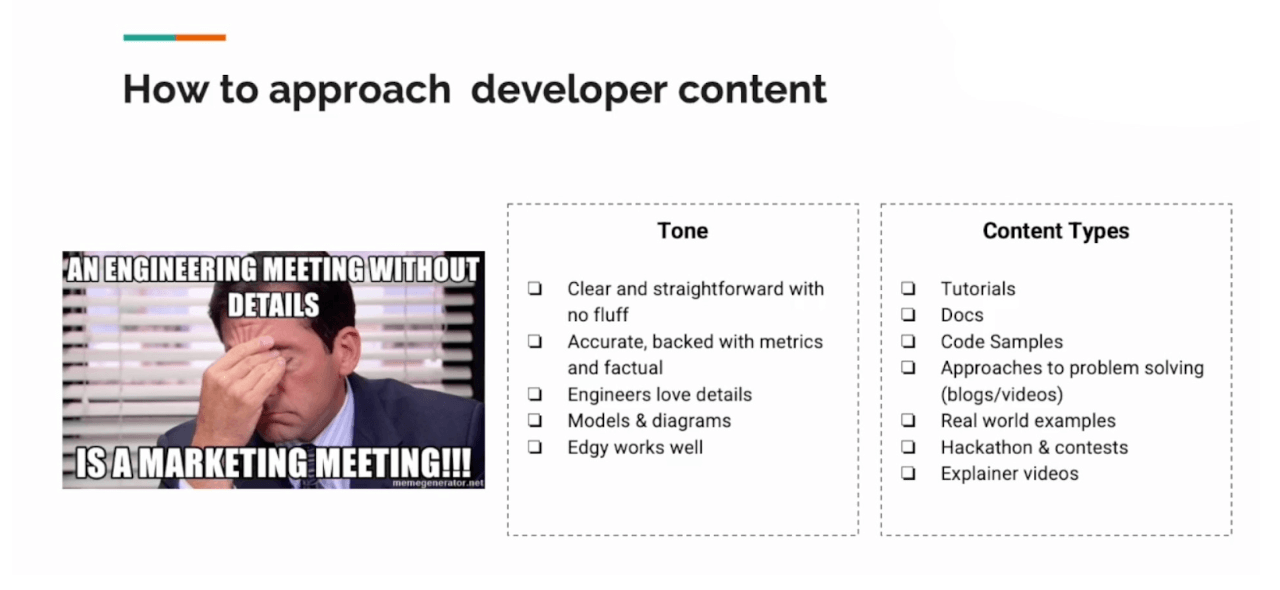
Here are some typical content types that appeal to developers:
- Tutorials
- Docs
- Code samples
- Approaches to problem-solving (blogs/videos)
- Real-world examples
- Hackathons and contests
- Explainer videos
Where to uncover compelling topics for developers
Let’s explore a few of my favorite sources of compelling topics for developer content.
Staff interviews
Interview your dev rel team, your product team, and engineers. That's a great place to begin, as these stakeholders can provide the level of technical depth and detail that your dev audiences will appreciate.
Your BD teams are extremely close to customer problems and pain points, so their suggestions can help you produce content that will align with your prospects and target customers.
Topics can span a variety of themes. I've seen content that runs the gamut of product launches, product updates, typical customer use cases, and much more.
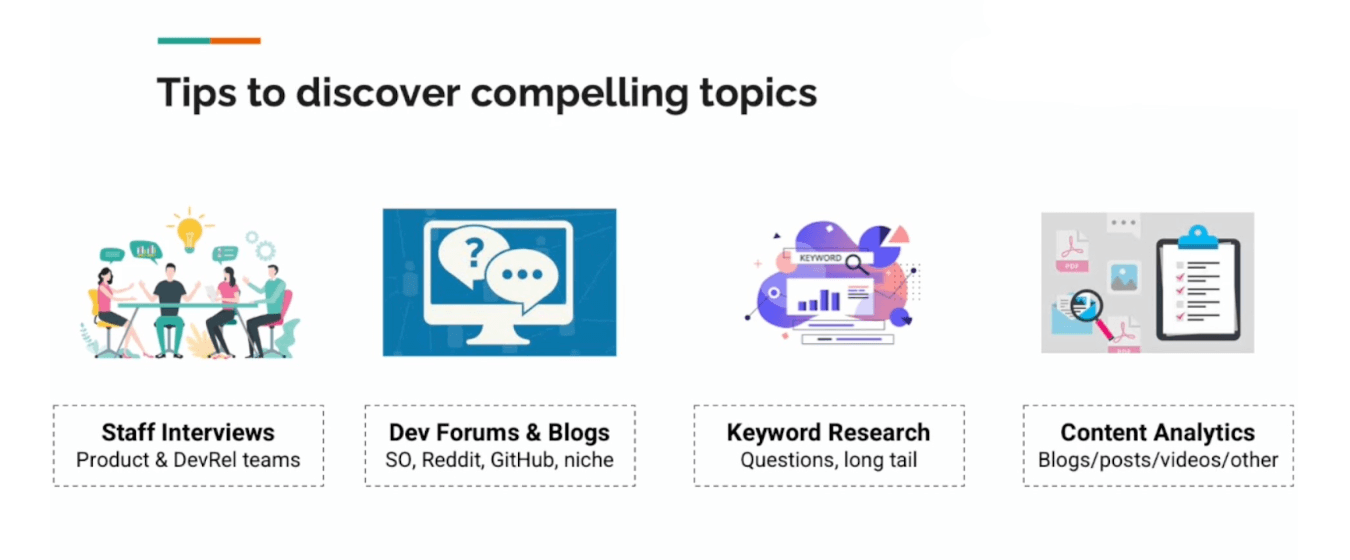
Developer forums and blogs
Searching sites like Stack Overflow, Reddit, and GitHub will help you find topics. These are rich sources of insight and knowledge into your target audiences. By identifying the most popular topics and the most engaged-with threads, you can start planning and prioritizing the topics you wish to tackle.
I also use a lot of niche blogs, such as KDnuggets or Data Science Central, when working with data scientists. These niche publications can also contain a lot of valuable insights.
Keyword research
Another source of insight that I've become a fan of is keyword research. Developers extensively rely on Google Search to solve problems, look for solutions, and carry out research, so a rigorous approach to SEO research on depth topics can provide a wealth of insights.
Content analytics
Finally, if you have a steady pipeline of content, or publish content that's already getting good traction or developers, it might be helpful to look at the analytics of your existing content to understand what worked well and why. You can then build upon that success for future content.
Why running developer campaigns is hard
Now that you've spent precious time building personas and content, it's time to translate them into measurable business impact. First, you’ll need to start thinking about your campaigns and ways to measure impact.
Unfortunately, like other aspects of developer marketing, running dev campaigns comes with its own set of headaches and challenges. Have you ever run into a situation where it wasn't possible to reach your desired dev audiences? You’re not alone. Most organizations that I've worked with have encountered these two problems:
Problem #1: Developer advertising is expensive and challenging
Advertising platforms like Google and Facebook are built for B2C advertisers in large consumer businesses. Their targeting options barely cover developers, let alone your niche developer audiences.
On the other side of the web, you have highly specialized devlogs and sites - the likes of Reddit, Quora, and Stack Overflow of the world - which arguably weren't built for advertising.
Sure, you can get a lot of qualified eyeballs on your content, but you might find that you're spending six to seven times what you would have spent on Google or Facebook for a similar quality of leads.
Problem #2: Dirty CRM data
The second major problem relates to poor data hygiene in your CRM. Arguably, this is not limited to developer marketing. Data hygiene is notoriously bad in organizations large and small.
What makes it even more vexing when you're working with developer audiences is the fact that devs just don't like to work with gated content. A lot of times they will not fill out forms, and they may leave behind inaccurate, dirty data that is useless for your workhorse campaign channels like emails or eMarketing.
Persona maker: A tool for segmentation
In one of my earlier roles, I lead demand gen for an organization that built cutting-edge AI/ML tools and platforms for businesses of all sizes. Our primary audiences were AI and ML developers and Docman data engineers. We also tackled business decision-makers and influencers.
Over a few years, we built up a fairly sizable marketing and sales database, consisting of almost half a million leads. These leads came from many sources, including list buys, acquisition campaigns, customer support teams, and various form submissions.
The data quality, to put it mildly, was terrible. 30% of leads had no profile or job information. To make matters worse, our devs had entered 93,000 distinct job titles for the remaining 70%. That's a massive spread.
There was no way we could effectively segment our communications, so we were essentially spamming everyone in the database with all our emails and retargeting campaigns. Unsurprisingly, our content had some of the worst engagement rates and highest unsubscribe rates in the market.
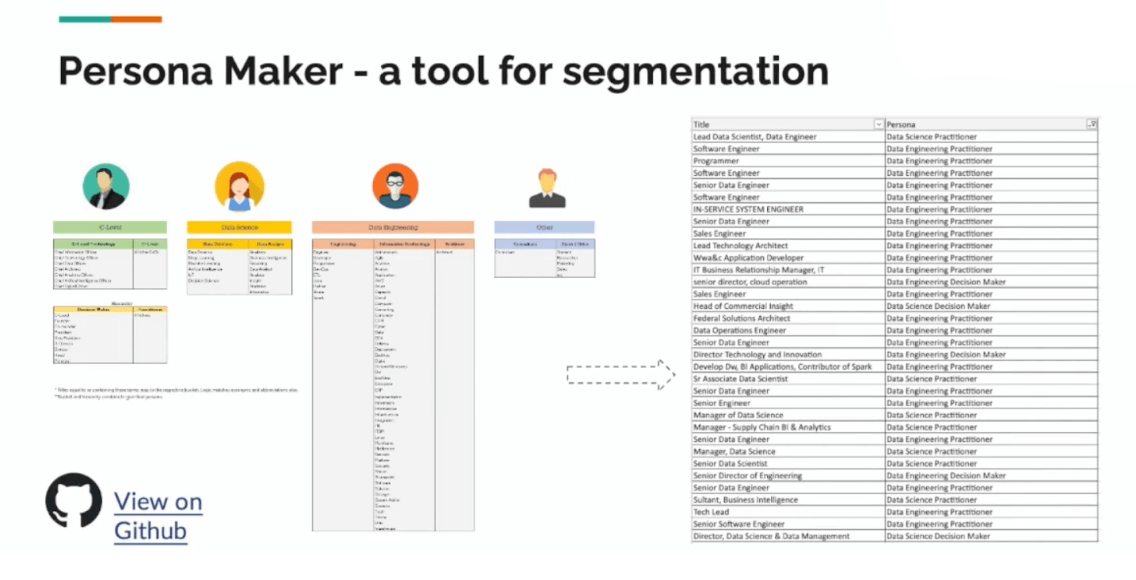
Clearly, we needed to do a better job of segmenting our touches, so I created a segmentation solution that allowed us to partly solve this problem. With this solution in place, we were able to cut unsubscribe rates by 40% and improve our campaign ROI by over 250%.
I have open-sourced the solution, and you can find it on GitHub here. Hopefully, it will serve you well in your developer campaigns. The code is completely flexible, so you can tweak the criteria to your liking and run with it.
This program is called Persona Maker, and it was built in Python. It looks at the job titles of your developers and sorts them into the right tier of decision-making authority and bucket of professional interest. This tool allowed us to condense the 93,000 job titles in our CRM into five distinct buckets.
You can take this Python-based program, upload your lists in CSV format, and quickly generate a table of labeled data. If you're marketing to AI or ML devs, you can use it as it is. If you want to repurpose the tool for a different developer persona or different sub-segments, you can share this code with your marketing ops team or CRM devs and work with them to adjust the prioritization.
Cheat sheet for developer campaigns
Now let's look at how to build successful dev campaigns. The advice I’m going to share comes purely from my own experience.
I encourage you to dive into this topic and check out other sources as there really is no one-size-fits-all. There's room for everyone to be creative when it comes to developer campaigns.
However, there are certain principles that work well, which I'd like to share. Take a look at my cheat sheet below.
On the left, I've listed some popular campaign types that have worked well for me, and on the right, I've listed the digital channels that I've used to engage devs. I've also listed the tactics that have worked well within each channel.
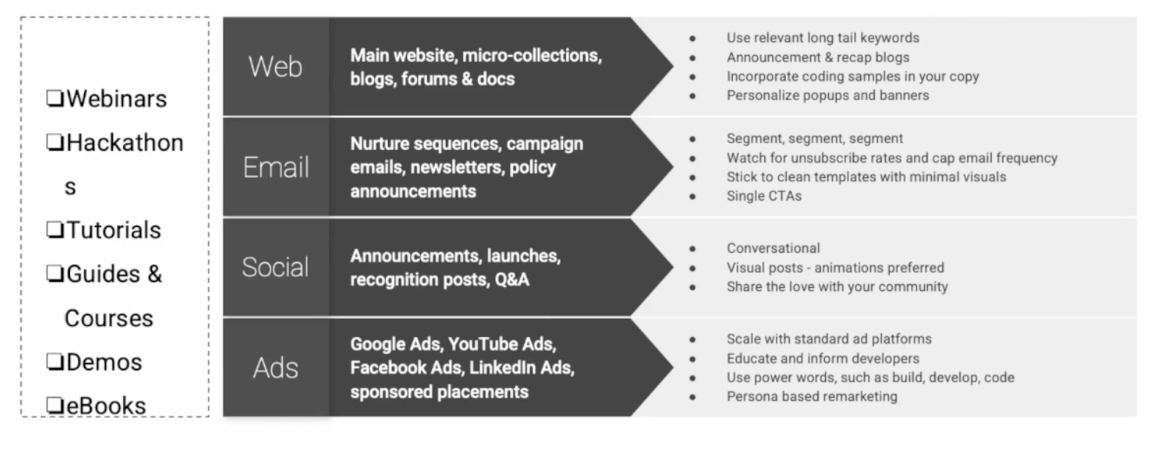
KPIs for marketing and content performance
After we launch a developer marketing campaign, it’s vital that we measure our impact. I'd like to share the most important metrics I've seen over the years in developer marketing.
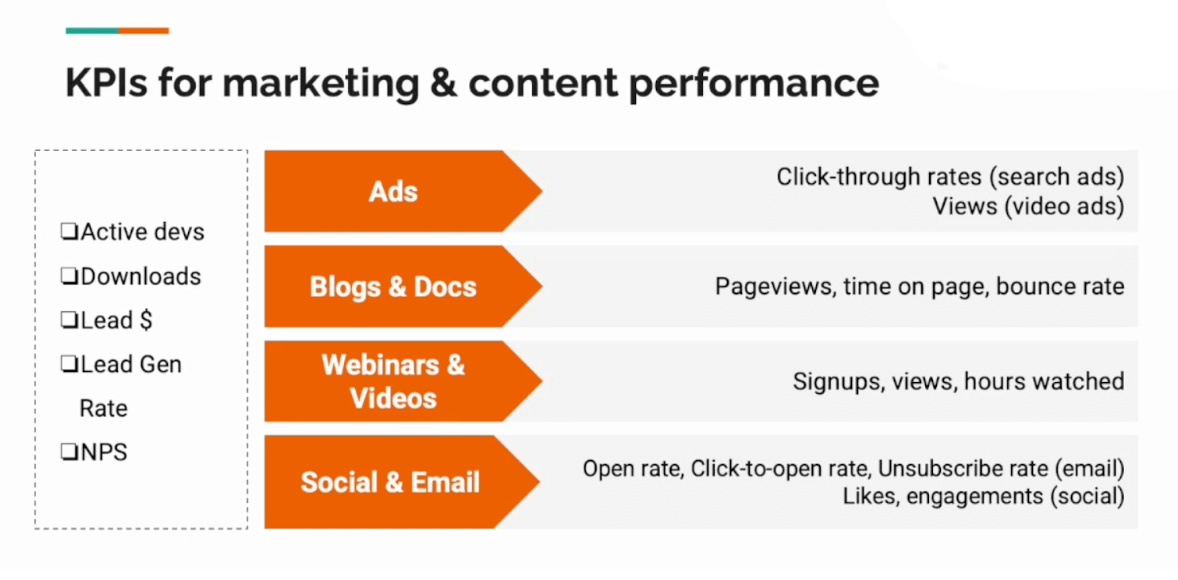
Your primary KPIs will typically include active developer counts, product usage or downloads, revenue, and/or developer satisfaction. Of course, there are many variations and the list can vary based on your industry or targets.
Channel-level engagement metrics vary by channel and can ladder up to top-level metrics. I watch these channel metrics very closely because they're a good leading indicator of how well your content is engaging your audiences and therefore moving the top line. Take a look at the image above to see exactly which metrics you can track for each channel.
Takeaways
We've covered a lot of material today and touched on important topics that merit further deep dives. Let's recap what we’ve learned.
- We noted why It's important to understand developers and developer marketing.
- We saw a process to build dev personas that align with your business.
- We explored developer psychology and saw how to create compelling content for these audiences.
- We discovered the power of segmentation and walked through a powerful tool for segmenting your developers.
- We explored a cheat sheet with campaign offers and channel-level best practices for dev campaigns.
- Finally, we looked at a framework for measuring the effectiveness of your dev marketing.
It's been an absolute pleasure to share this with you. Thank you for your time.


















 Follow us on LinkedIn
Follow us on LinkedIn



.svg?v=3c4c23cd72)